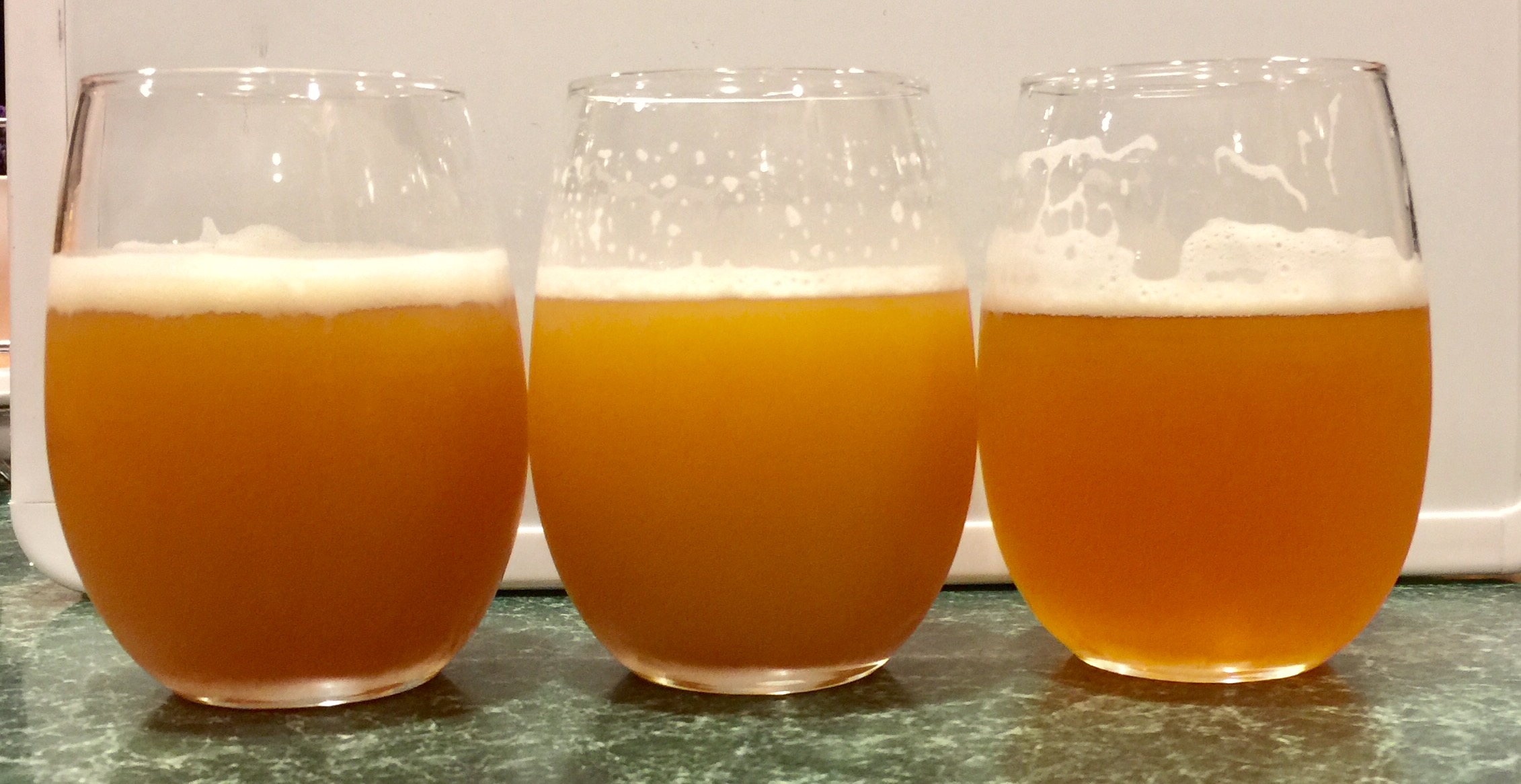Sorry for the delay getting this posted. Here are the results from my split-batch experiment. Recipe details are in the quote above.
From left to right in the picture:
1.) WY1318 with CO2 tank carbonation
2.) WY1318 with natural CBC-1 carbonation
3.) S04/T58/WB06 with natural CBC-1 carbonation
These beers have been in the keezer under CO2 for pouring for ~12 days now. Each keg had 1.5oz Citra & Mosaic added as keg-hopping.
Visual:
Interesting that the natural-carbed WY1318 batch is lighter in color than the C02 tank-carbed one. Probably represents less oxidation? The S04/T58/WB06 started off slightly less cloudy than the WY1318 but now the difference is very noticeable. Even moreso than the picture represents. But it is still slightly hazy.
The two naturally-carbed beers have a denser, creamier head to them. IT also lasts longer than the CO2-carbed version.
I did blinded triangle testing for the 3 beers. I was able to pick out the different beer consistently. The differences in taste, aroma, and mouthfeel were fairly impressive. Of note, I also submitted the WY1318 beers to triangle testing for 8 of my drinking buddies. Only one couldn’t correctly tell the difference between the natural carbed and C02 tank carbed beers.
These are my tasting notes:
Aroma:
There are very noticeable differences in aroma between the WY1318 and SO4/T58/WB06. Both WY1318 beers have similar aroma. The naturally-carbed one has a bit stronger aroma (after 12 days in the keezer) c/w C02-carbed. Both have a great pineapple, orange, peach, and mango aroma. The SO4/T58/WB06 beer still has a juicy fruit gum, orange, pineapple aroma, but the aroma has now become more muted than the other 2 beers. Interestingly, it had much stronger aroma than the other two during both sample readings pre-transfer to the keg carbing.
Taste/Mouthfeel:
Both 1318 beers have tastes of pineapple, mango, orange, tart grapefruit, & a little bit of berry. The natural carbed one’s tastes definitely are cleaner and stronger and it has a Smoooooooth mouthfeel and the carbonation is what I’d describe as more “gentle on the tongue”.
The S04/T58/WB06 beer has notes of sweeter grapefruit, peach, and mango. I don’t get any berry flavors from it. It finishes with ever so slight spicyness that the other beers definitely don’t have. The mouthfeel is nice and soft though, with very pleasant carbonation. It is a great beer, but is the least “Treehouse-style NEIPA” of the bunch.
Very interesting parallel experiment results. My takes from it:
-WY1318 makes a fabulous NEIPA all by itself
-Natural carbing makes a noticeable difference.
-The recipe and yeast ratio that I used for the “TH yeast” batch are not that close to what TH is doing.
-I made 3 batches of the same exact grainbill and hop schedule beer that ended up being substantially different beers in the end due to yeast selection and carbonation method…proving once again how many variables influence beers!













![Craft A Brew - Safale BE-256 Yeast - Fermentis - Belgian Ale Dry Yeast - For Belgian & Strong Ales - Ingredients for Home Brewing - Beer Making Supplies - [3 Pack]](https://m.media-amazon.com/images/I/51bcKEwQmWL._SL500_.jpg)













































